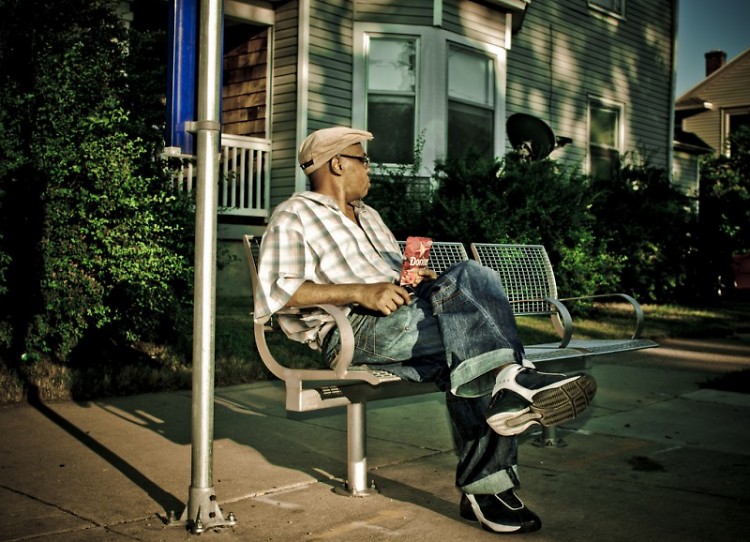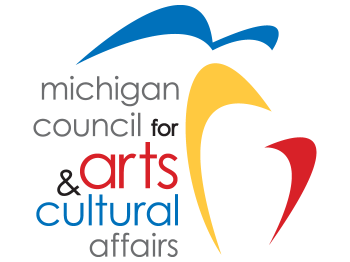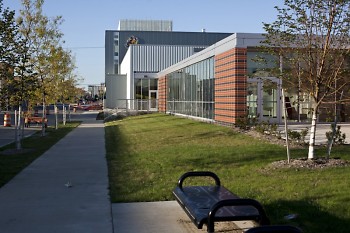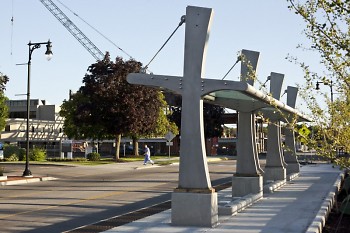Our editor sat down with Bill Kirk, the new Transportation Demand Manager of Downtown Grand Rapids Inc., to talk about all things transportation in Grand Rapids. Kirk still works very closely with The Rapid on a variety of issues, and as their former public outreach coordinator, was able to answer our questions about the upcoming Bus Rapid Transit (BRT).
Holly Bechiri: We've been noticing a lot of construction happening to get ready for the new BRT slated to start running late summer of next year. How's everything going with that?
Bill Kirk: The original timeline is still on schedule. We’ll be completing 29 of the 33 stations this year, and the four remaining ones will be completed next spring. We are on track to start providing service on the BRT line in August of 2014.
HB: Any new developments we should know about?
BK: There have not been any noteworthy changes to the project plans themselves, but there has been some very exciting transit oriented development taking place in the corridor. For instance, work has been completed on the University Prep Academy at Division and Buckley, expansions and planned developments are taking place at Mercy Health (St. Mary’s), as well as Fulton and Division (the new Brookstone Capital project), the Inner City Christian Federation’s (ICCF) development continues at Wealthy and Division, and mixed use development is beginning to cluster around the new Downtown Market. In addition, the cities of Grand Rapids, Kentwood and Wyoming are simultaneously working on street enhancements in the corridor (up and down Division, on Jefferson and on Ransom). Overall, we’ve been fortunate to have willing partners, both public and private, that are leveraging the investment being made in the BRT, which is creating a stronger corridor and catalyzing economic development. You'll want to check out a recent article from the Atlantic Cities for a little larger context related to the economic benefits of transit:
HB: What are the top benefits you see to the city from this project?
BK: This will be an incredibly effective and efficient mobility option that will provide express service to riders, and for those commuting in other modes, every additional rider on the BRT is one less car in traffic to compete with. Second, the economic development that this project will create and support will provide an incredible benefit to the city. We are already seeing this with the projects mentioned before, and we see it in cities across the country and around the world with BRT systems that have literally laid the groundwork for billions of dollars in investment and economic activity. Finally, this is the first Bus Rapid Transit line in Michigan. This raises the profile of Grand Rapids both in the state and nationally, which helps to make our community attractive to young talent looking for a progressive city with great infrastructure, which is a critical factor in the sustained success of the city and the region.
HB: How do you see BRT as the right response to transportation needs, and how does that benefit a growing city?
BK: The demand on our transportation infrastructure is only increasing, especially in the Division corridor... It is the right response for a variety of reasons, including the fact that demand is increasing very quickly, but also because BRT is incredibly efficient from a cost perspective. To build a BRT system costs about 1/10 of what building a light rail system would, so it truly is the biggest bang for the buck. It benefits a growing city because it will address demand, and lay the foundation for additional projects as the city continues to grow. BRT is a proven contributor to economic development and vitality, as well.
HB: What goes into transportation planning as it relates to city planning?
BK: Because this construction is funded primarily with federal dollars, the planning process is exhaustive. The Federal Transit Administration is extremely focused on ensuring that it invests limited, competitive transportation dollars wisely, so a project like this has to meet extraordinarily strict and demanding criteria. Over the last decade, The Rapid has engaged in extensive alternative analyses studies, environmental impact studies, economic development potential projections and an incredible amount of public outreach and input.
Working with the community and all relevant stakeholders to identify the right transit mode that meets the mobility demands of the corridor while simultaneously promoting economic development and spending public dollars responsibly has been the main focus of our team for years. As it relates to city planning, we’ve been extremely fortunate to have great partners in the cities of Grand Rapids, Kentwood and Wyoming from the very beginning of this project. Officials from each city have been involved in every step of the planning process, so we have been able to coordinate development plans on all levels to make sure that the BRT project is complimentary to each city’s master plan and vision.
HB: What do our placemaking/citybuilding/urbanists need to know about this project?
BK: The placemaking/citybuilding/urbanists need to know that this project is going to change Grand Rapids dramatically, for the better. It is the first step in a robust, long-term enhancement of our transit system, and its success will pave the way for additional projects like more BRT lines, streetcars, and other transformative pieces of transportation infrastructure. They also need to understand the economic impact of an investment of this size and scope, which is already happening in real time.
HB: And conversely, what do those who worry about large dollars spent on public transport need to understand about this project?
BK: Detractors need to understand that our community is constantly sending our transportation dollars to Washington DC, and in the past those dollars have generally gone to other communities that are willing to invest in their transportation infrastructure.
This project represents one of the first times that extremely competitive transportation dollars have come back to our community to be invested HERE. They also need to understand that the notion that investment in transportation infrastructure does not have an enormous, positive economic ripple effect is completely wrong.
Investing in transit benefits everyone.
The Rapidian, a program of the 501(c)3 nonprofit Community Media Center, relies on the community’s support to help cover the cost of training reporters and publishing content.
We need your help.
If each of our readers and content creators who values this community platform help support its creation and maintenance, The Rapidian can continue to educate and facilitate a conversation around issues for years to come.
Please support The Rapidian and make a contribution today.



